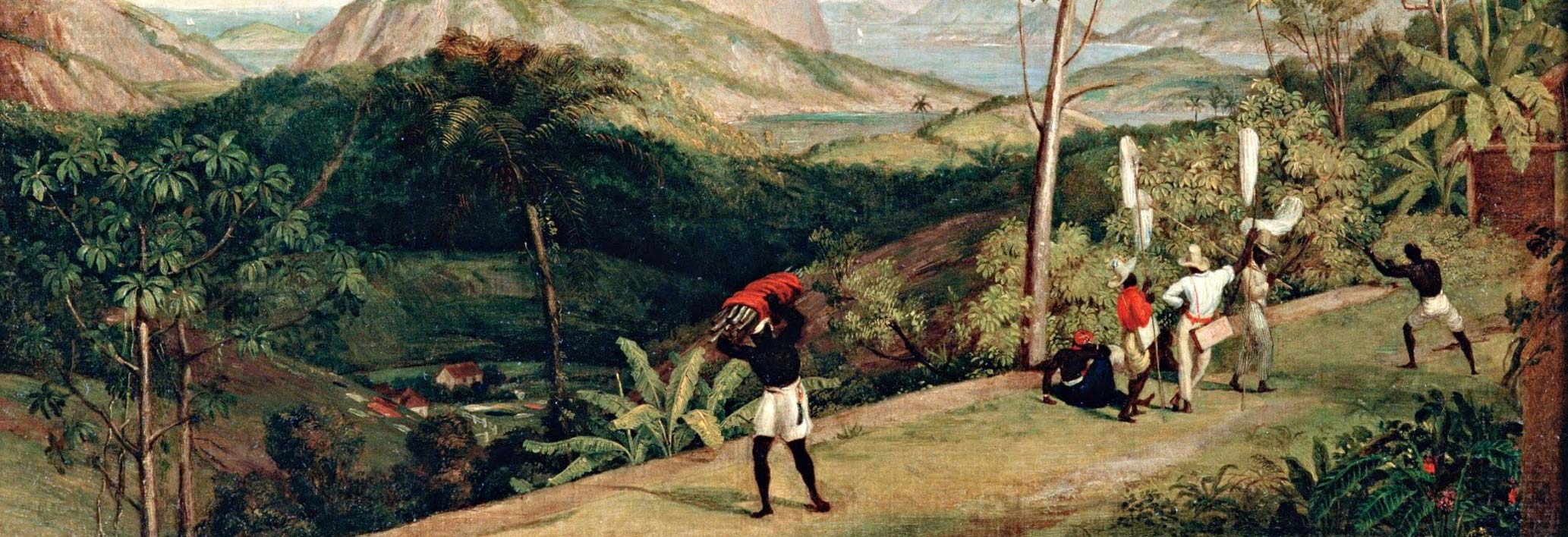Manuel da Cunha was a painter born into slavery in Rio de Janeiro, in the Portuguese colony of Brazil.
Cunha took his surname from the family for whom his enslaved mother worked at the time of his birth. He showed a talent for painting from an early age and began to study with João de Sousa, an established religious painter in Rio. Sousa’s mastery of Brazilian baroque painting and many commissions influenced Cunha’s style and likely helped to expand his professional connections.
Cunha completed his most famous work in 1757: a half-length portrait of Gomes Freire de Andrade, First Count of Bobadela, painted for the Convent of Santa Teresa (now hanging in the Rio city council building). This was a major accomplishment for someone only 20 years old and still enslaved. Cunha’s reputation as an artist grew, eventually reaching wealthy businessman José Dias da Cruz. Cruz would serve as Cunha’s main benefactor through the end of the eighteenth century.
In 1794, Cunha completed a commission for a series of paintings in the Novitiate Chapel of the Church of the Third Carmelite Order. Around the same time, he completed a series of portraits of benefactors for a charity, Holy House of Mercy. Following the completion of these commissions, Cruz, wishing to further Cunha’s artistic education, paid for Cunha to study in the art academies of Lisbon. Cunha left for Lisbon around 1795, but it is unclear how long he stayed. Upon his return to Brazil, Cruz then purchased Cunha’s freedom. Unencumbered by enslaved status, Cunha took on a wider range of commissions and established himself as a painting instructor, teaching twelve students in his home.
Contemporary scholars debate Cunha’s classification as a member of the Fluminense School of painting, a grouping of late-eighteenth- and early-nineteenth-century Rio artists. In any case, his many commissions for prominent churches and religious orders attest to his artistic influence in the city during his life.
The majority of Cunha’s works are difficult to date with certainty. Among his major church commissions is a scene of the Descent from the Cross in the Chapel of Our Lord of the Steps in the Church of Our Lady of Mount Carmel, Rio de Janeiro’s main cathedral from 1808 to 1976. Two other influential works are his side panels for the Church of Saint Sebastian, including Saint Andrea Avellino, as well as those for the Chapel of Our Lady of Victories of the Church of Saint Francis of Paola. These paintings include Miracles of Saint Francis of Paola and The Holy Patriarch in Prayer to the Virgin Mary. Cunha also completed a series of paintings for the Monastery of Saint Benedict and a painting of the Virgin Mary titled Our Lady of the Conception, which hangs in the Brazilian National Museum of Fine Arts. He is also credited with creating the processional banners of the Church of Our Lady of Good Success, which are still paraded annually.
Cunha died on April 27, 1809 and is buried in the Church of the Venerable Third Order of Our Lady of the Conception and Good Death in Rio de Janeiro.
Bibliography
Gomes, Guilherme Simões, Jr. “Vidas de artistas: Portugal e Brasil.” Revista Brasileira de Ciências Sociais 22, no. 64 (2007): 33–47.
Leite, José Roberto Teixeira. “Negros, Pardos, e Mulatos na Pintura e na Escultura Brasileira do Século XVIII.” In A Mão Afro-Brasileira: Significado da Contribuição Artística e Histórica, edited by Emanoel Araújo, pp. 1–72. São Paulo: Imprensa Oficial do Estado de São Paulo/Museu AfroBrasil, 2010.
Porto-Alegre, Manuel de Araújo. “Memória sobre a antiga Escola Fluminense de Pintura.” Revista Trimensal de Historia e Geographia, ou Jornal do Instituto Historico e Geographico Brasileiro 3 (1841): 549–557.
Rarey, Matthew Francis. "Cunha, Manuel da." Dictionary of Caribbean and Afro-Latin American Biography , edited by Ed. Franklin W. Knight. , edited by and Henry Louis Gates Jr.. . Oxford African American Studies Center, http://www.oxfordaasc.com/article/opr/t456/e583 (accessed Thu Sep 05 12:48:55 EDT 2019).
Valladares, Clarival do Prado. “Notícia sobre a pintura religiosa monumental no Brasil.” In O Universo Mágico do Barroco Brasileiro, edited by Emanoel Araújo, pp. 199–245. São Paulo: SESI, 1998.
Author
Matthew Francis Rarey
Adapted by
James Almeida and Steven J. Niven
Contributing Institutions
Hutchins Center for African & African American Research, Harvard University, Cambridge, MA.
Oxford University Press (USA) African American Studies Center.







